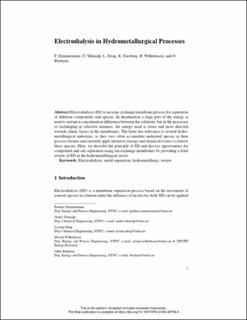| dc.contributor.author | Zimmermann, Pauline | |
| dc.contributor.author | Tekinalp, Önder | |
| dc.contributor.author | Deng, Liyuan | |
| dc.contributor.author | Forsberg, Kerstin | |
| dc.contributor.author | Wilhelmsen, Øivind | |
| dc.contributor.author | Burheim, Odne Stokke | |
| dc.date.accessioned | 2021-06-04T11:39:20Z | |
| dc.date.available | 2021-06-04T11:39:20Z | |
| dc.date.created | 2020-09-02T13:47:24Z | |
| dc.date.issued | 2020 | |
| dc.identifier.citation | Rare Metal Technology 2020 | en_US |
| dc.identifier.isbn | 978-3-030-36758-9 | |
| dc.identifier.issn | 2367-1181 | |
| dc.identifier.uri | https://hdl.handle.net/11250/2757960 | |
| dc.description.abstract | Electrodialysis (ED) is an ionic exchange membrane process for separation of different components and species. In desalination, a large part of the energy is used to sustain a concentration difference between the solutions, but in the processes of exchanging in selective manners, the energy need is lower and more directed towards ohmic losses in the membranes. The latter has relevance to several hydrometallurgical industries, as they very often accumulate undesired species in their process streams and currently apply intensive (energy and chemical) routes to remove these species. Here, we describe the principle of ED and discuss opportunities for component and salt separation using ion-exchange membranes by providing a brief review of ED in the hydrometallurgical sector. | en_US |
| dc.language.iso | eng | en_US |
| dc.publisher | Springer | en_US |
| dc.relation.ispartof | Rare Metal Technology 2020 | |
| dc.relation.ispartofseries | The Minerals, Metals & Materials Series;2020 | |
| dc.relation.uri | https://link.springer.com/content/pdf/10.1007%2F978-3-030-36758-9.pdf | |
| dc.title | Electrodialysis in Hydrometallurgical Processes | en_US |
| dc.type | Chapter | en_US |
| dc.type | Peer reviewed | en_US |
| dc.description.version | acceptedVersion | en_US |
| dc.source.pagenumber | 159-167 | en_US |
| dc.identifier.cristin | 1826780 | |
| cristin.ispublished | true | |
| cristin.fulltext | postprint | |
| cristin.qualitycode | 1 | |
